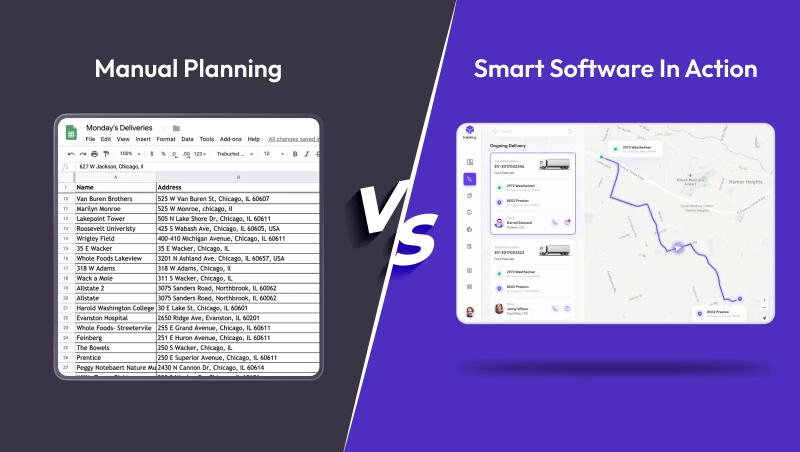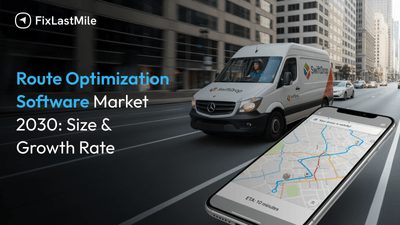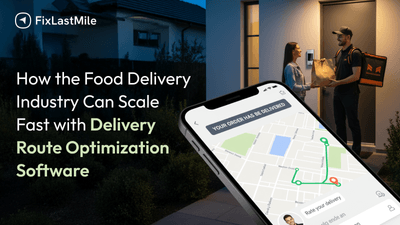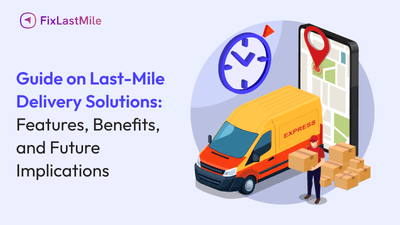They say the last mile is short in distance but long in cost, complexity, and consequences.
In the world of logistics, the last mile is where everything either falls apart or comes together. It’s the final step that connects your product to your customer, and yet, it remains the most expensive and unpredictable stage in the supply chain.
According to McKinsey, last-mile operations consume over 50% of logistics budgets, rendering it the most costly segment. While customer expectations continue to rise (real-time tracking, precise ETAs, contactless delivery), many businesses still rely on outdated methods to manage deliveries.
So how do you stay fast, accurate, and cost-efficient, especially when every second counts?
The answer lies in smarter last mile delivery technology. In this blog, we’ll explore the real-world delivery problems faced by logistics teams, explain how software resolves them, and show how Fixlastmile helps improve operational efficiency, customer satisfaction, and business scalability.
Why Last-Mile Delivery Is So Challenging
Last-mile logistics isn't just about taking a package from Point A to Point B. It involves a complex network of decisions, routes, schedules, customer preferences, and unpredictable events.
Here are the typical roadblocks faced by delivery teams.
1. Poor Route Planning Leads to Delays and Wasted Resources
Manual route planning or using basic mapping tools often ignores real-time conditions like traffic congestion, road closures, or last-minute delivery changes. This results in:
- Longer delivery times
- More fuel usage
- Fewer deliveries per driver
Even minor inefficiencies, when unchecked, can gradually lead to higher costs and reduced output.
2. No Real-Time Visibility Creates Operational Blind Spots
Without a real-time delivery tracking system, dispatchers and managers have no insight into what’s happening on the road. They can’t tell where a driver is, whether a package was delivered, or if an issue needs escalation.
This leads to:
- Increased customer complaints
- Delayed responses to problems
- Higher pressure on support teams
3. Manual Dispatching Slows Down the Process
Manually assigning deliveries through spreadsheets or basic software becomes chaotic as volume increases. Under the strain of peak demand, this system often cracks, which resulting in delaying orders and choking the delivery flow.
4. Customers Don’t Receive Accurate ETAs
Today's customers expect more than just a delivery; they expect updates. Inaccurate or missing ETAs can create uncertainty, leading to poor delivery experiences and negative feedback.
5. Disconnected Systems Block Scalability
Using separate tools for route planning, fleet tracking, and performance monitoring slows down decision-making. Without centralised data, it becomes difficult to measure performance or spot inefficiencies.
What Makes the Last Mile So Complex?
The final mile involves real-world, real-time variables that are constantly changing:
- Unexpected traffic jams or accidents
- Drivers calling in sick
- Delivery addresses with limited access (gated buildings, rural homes)
- Customer cancellations or reschedules
- Weather disruptions
- Peak season surges
Add to that the pressure for faster delivery promises, same-day fulfillment, and contactless options, and you have a recipe for chaos, unless you're backed by a system that can respond, adapt, and optimize on the go.
How the Right Software Solves These Problems
Investing in the right last mile delivery optimization software allows businesses to automate, streamline, and scale their delivery operations. Let’s break down the specific aspects where software adds clear value:
Route Optimization: Plan Smarter, Deliver Faster
Advanced software calculates the fastest and most cost-effective routes using real-time data like traffic, order locations, delivery time windows, and driver availability.
This helps your fleet avoid delays, complete more deliveries per shift, and reduce fuel consumption, all without manual planning.
By optimizing delivery sequences, the system also groups nearby deliveries together to minimize backtracking.
Explore how Fixlastmile’s Route Optimization Software improves fuel efficiency and reduces delivery times.
Real-Time Tracking: Total Visibility for Teams and Customers
A powerful delivery tracking system allows managers to view every package, vehicle, and delivery status in real time. This visibility improves control and coordination.
Customers also benefit, they receive accurate ETAs, live updates, and instant alerts for delays. This not only builds trust but reduces support calls and improves satisfaction scores.
Tracking also helps teams quickly respond to exceptions, like a missed address, a reroute request, or an on-the-ground issue reported by the driver.
See how our Delivery Management Features provide end-to-end visibility.
Automated Dispatching: Reduce Manual Work and Human Errors
Manually assigning deliveries is slow and risky, especially during high-volume days.
Delivery management software automatically assigns jobs to the best-suited drivers based on availability, proximity, and workload. This ensures:
- Faster dispatching
- Balanced workloads
- Fewer errors in driver assignments
For large fleets or rapidly growing businesses, automation is the key to maintaining speed and accuracy without adding more dispatchers.
Performance Analytics: Data-Driven Delivery Improvement
The right software doesn’t just track deliveries; it tracks performance.
You get access to real-time dashboards showing:
- On-time delivery rates
- Fuel usage
- Driver performance
- Reasons for failed or delayed deliveries
These insights help you identify patterns, measure KPIs, and optimize everything from route planning to driver incentives.
Discover how Fixlastmile’s Logistics Software for Businesses helps teams operate smarter.
What You Gain with the Right Last Mile Software
When delivery operations run efficiently, everything improves, costs go down, speed goes up, and customers stay happy. Here are the most common benefits businesses see after implementing the right solution:
- Cut fuel and workforce expenses by as much as 25%.
- Higher delivery success rates, even with fewer drivers
- Improved customer communication and satisfaction
- Increase daily deliveries without adding more vehicles.
- Scalable systems that grow with your business
- Improved visibility means fewer calls and emails to your support team
Why Choosing the Right Software Matters

Not all delivery software is designed for the demands of the modern last mile. Many tools offer basic route planning or tracking but fail to provide automation, integration, and deep analytics.
Here’s what you should look for in a solution:
- Cloud-based architecture for flexibility and scalability
- Mobile-first driver apps with navigation and offline support
- One dashboard for route planning, dispatching, and tracking
- Instant notifications, digital proof of delivery, and real-time ETA tracking
- Custom integration options (for ERP, CRM, and eCommerce platforms)
Fixlastmile is built specifically for modern delivery challenges, offering automation, real-time visibility, and control all in one place.
Who Should Use Last Mile Delivery Software?
Whether you're a large enterprise or a growing delivery business, the need for better last-mile tools is universal.
Ideal users include:
- 3PL and courier companies handling daily delivery loads
- eCommerce brands fulfilling high volumes with tight deadlines
- Pharmaceutical and food companies with time- or temperature-sensitive items
- Fleet operations teams managing deliveries across multiple zones
- Startups building efficient delivery models from the ground up
Even if you have a small fleet, you can benefit from automation, tracking, and better customer communication.
Checklist: What to Look for When Choosing a Platform
Before you invest in delivery management software, make sure it includes these essential features:
Must-Haves:
- Smart route optimization
- Real-time tracking of vehicles and orders
- Automated dispatching
- Driver app with navigation and proof of delivery
- Live ETAs and customer notifications
- Easy-to-read dashboards and reports
- API integration with your existing tools
Bonus Features:
- Heatmaps and delivery zone analysis
- Exception alerts and rescheduling options
- Customer feedback capture
- Support for contactless delivery
Explore our complete list of Delivery Management Software Features to find your perfect fit.
Final Thoughts: Don’t Let the Last Mile Become the Weakest Link
Today’s customers expect fast, accurate, and visible delivery experiences. If your last mile is still managed manually or with disconnected tools, it’s likely hurting more than just your margins, it’s affecting your brand. With the right last mile delivery software, you can finally take control of delivery chaos, build customer trust, and grow your business with confidence.
It’s no longer about whether to adopt technology, it’s about choosing the right platform that gives you speed, control, visibility, and insights.
Time to upgrade how you manage deliveries and are you in? Book a free demo with Fixlastmile and see how we can help.
FAQs
It’s a system that helps businesses plan, track, and manage the final step of delivery, from warehouse to doorstep, using smart automation and real-time tools.
By optimizing routes, automating dispatch, and improving delivery accuracy, it helps reduce fuel usage, labor time, and customer complaints.
Yes. Even small teams benefit from faster dispatching, better tracking, and improved customer experience with the right software.
Because it offers real-time tracking, smart dispatch, route optimization, and performance analytics, all in one easy-to-use platform.




